How to convert iterated integrals into polar coordinates
Iterated integrals vs. double integrals
To change an iterated integral to polar coordinates we’ll need to convert the function itself, the limits of integration, and the differential.
Hi! I'm krista.
I create online courses to help you rock your math class. Read more.
To change the function and limits of integration from rectangular coordinates to polar coordinates, we’ll use the conversion formulas
???x=r\cos{\theta}???
???y=r\sin{\theta}???
???r^2=x^2+y^2???
Remember also that when you convert ???dA??? or ???dy\ dx??? to polar coordinates, it converts as
???dA=dy\ dx=r\ dr\ d\theta???
If we start with a double integral, we’ll need to first evaluate it, select which region type it is and then set up our limits of integration. After this, our double integral is an iterated integral so we just use the same techniques to solve for the polar coordinates.
How to convert iterated integrals from rectangular coordinates into polar coordinates
Take the course
Want to learn more about Calculus 3? I have a step-by-step course for that. :)
Evaluating double integrals after converting from rectangular coordinates to polar coordinates
Example
Convert the double integral from rectangular coordinates to polar coordinates, if ???D??? is bounded by ???y=\pm\sqrt{25-x^2}???.
???\int\int_D\cos{\left(x^2+y^2\right)}\ dA???
First we’ll need to convert our double integral into an iterated integral. The first step in this is to evaluate ???D??? to determine what region type it is. If we rearrange ???D??? we’ll get ???x^2+y^2=25???, which means that the region is a circle that we can treat as a type I region.
This means that our outer integral will be with respect to ???x??? and our inner integral will be with respect to ???y???. We can start by finding the limits of integration of our inner integral. We have actually been given this information which is ???y=\pm\sqrt{25-x^2}???. We can put this into our integral.
???\int\int^{\sqrt{25-x^2}}_{-\sqrt{25-x^2}}\cos{\left(x^2+y^2\right)}\ dy\ dx???
Next we can find the limits of integration of our outer integral. Since our function is a circle with radius ???5???, our limits of integration will be ???\pm5???. We can put this into our integral.
???\int^5_{-5}\int^{\sqrt{25-x^2}}_{-\sqrt{25-x^2}}\cos{\left(x^2+y^2\right)}\ dy\ dx???
To change an iterated integral to polar coordinates we’ll need to convert the function itself, the limits of integration, and the differential.
Now we’re ready to convert it to polar form. Using the conversion formulas, we get
???\int^5_{-5}\int^{\sqrt{25-x^2}}_{-\sqrt{25-x^2}}\cos{\left(r^2\right)}r\ dr\ d\theta???
Next we need to change the limits of integration into polar form. We can start with the inner integral which is with respect to ???r???. The lowest value that ???r??? can have in our function is ???0??? and the highest value ???r??? can have is the radius of the circle which is ???5???. We can put these into our integral now.
???\int^5_{-5}\int^5_0\cos{\left(r^2\right)}r\ dr\ d\theta???
Now, we can change the limits of our outer integral. The outer integral is now with respect to ???\theta???. Since our function is a circle, the lowest angle it can have is ???0??? and the highest angle it can have is ???2\pi???. We can place these into our integral.
???\int^{2\pi}_0\int^5_0r\cos{\left(r^2\right)}\ dr\ d\theta???
This is the same double integral we started with, except that we’ve converted it from rectangular coordinates to polar coordinates.






